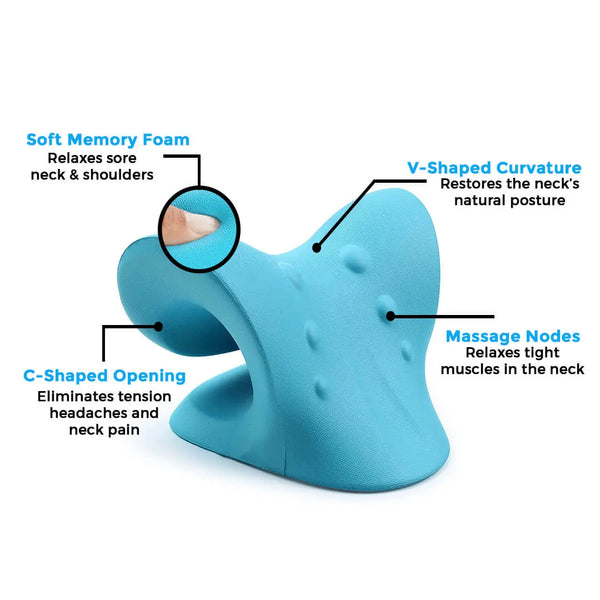Neck Cloud Review: A Revolutionary Tool for Neck and Spine Health
Neck Cloud Review: A Revolutionary Tool for Neck and Spine Health
Blog Article
Neck Discomfort in the Office: Identifying Danger Factors and Carrying Out Ergonomic Solutions
Neck discomfort in the office is a prevalent problem that can affect worker well-being and efficiency. By recognizing the numerous threat factors contributing to neck pain and executing ergonomic options, organizations can create an extra favorable job atmosphere.
Typical Reasons For Neck Discomfort
Neck discomfort in the workplace is a common problem that can be attributed to a number of common causes. Furthermore, recurring motions such as constant bending, turning, or getting to can likewise contribute to neck discomfort over time.

Ergonomic Danger Elements
Poor functional designs in the work environment can dramatically add to neck pain among employees. Factors such as inappropriate desk height, inadequate chair support, and unpleasant positioning of computer system screens can all contribute in the development of neck pain. When workers are compelled to sit for extensive periods in positions that stress their neck muscles, it can lead to stiffness, pain, and even extra significant bone and joint problems in time.
Additionally, bad ergonomic methods can result in workers adopting awkward postures while functioning, such as craning their necks to see a computer system screen or getting to uncomfortably for a computer mouse or key-board. neck cloud. These unnatural placements and repeated activities can put excessive tension on the neck and bordering muscle mass, bring about discomfort and reduced efficiency

Desk Arrangement Recommendations
To reduce the risk of neck discomfort and pain, there are a number of workdesk arrangement referrals that workers must consider. Make certain that the computer system monitor is placed at eye level to stop stressing the neck by looking up or down.
It is additionally essential to have appropriate illumination to decrease eye pressure, as scrunching up your eyes or leaning ahead can bring about neck tension. Organize the desk design to maintain regularly made use of items within arm's reach, restricting the need for repeated turning or reaching Website movements. By applying these workdesk configuration referrals, employees can develop a much more ergonomic work area that sustains neck wellness and minimizes the danger of developing work-related neck discomfort.
Stretching and Exercise Tips
Basic desk-friendly stretches can aid ease neck discomfort and protect against rigidity. Neck rolls, shoulder shrugs, and mild side-to-side neck stretches are reliable in easing stress.
It is necessary to take time-outs throughout the day to perform these workouts. Setting reminders or utilizing apps that trigger activity can assist develop a routine stretching routine. It's crucial to listen to your body and prevent overstretching, especially if you are new to these workouts. Consistency is vital, so aim to incorporate extending and workout into your everyday job routine. By focusing on these tasks, you can enhance your physical wellness, lower the threat of neck discomfort, and improve your total efficiency in the office.
Relevance of Regular Breaks
In a busy job atmosphere where demands can add to physical pressures like neck pain, establishing a regimen that stresses the significance of routine breaks Look At This is critical. By integrating short breaks into the job routine, employees can lower the threat of establishing neck pain and enhance total convenience and performance.
Regular breaks enable employees to rest their muscles, stretch, and alter positions, stopping stiffness and promoting much better flow. Encouraging employees to take short breaks every 30-60 minutes can help reduce the build-up of tension in the neck and shoulders. These breaks can likewise act as a chance for staff members to exercise leisure techniques or gentle neck stretches, even more advertising musculoskeletal wellness. Executing a culture that values and prioritizes routine breaks can have a significant influence on lowering neck pain and improving overall health in the workplace.
Verdict
To conclude, addressing ergonomic threat variables and applying appropriate workstation setups are necessary in reducing neck discomfort in the work environment. By advertising good pose, giving appropriate assistance, and encouraging normal breaks and stretches, organizations can produce a healthier and more effective workplace for staff members. Focusing on employee health via ergonomic solutions is crucial to stop discomfort and improving general workplace satisfaction.
Neck pain in the office is a common concern that can influence staff member well-being and productivity. By recognizing and dealing with these typical reasons of neck discomfort in the office, employers can take positive steps to develop an extra ergonomic and comfy work setting for their workers.
Poor comfort designs in the workplace can dramatically contribute to neck pain among staff members. By applying these workdesk arrangement recommendations, employees can create a much more ergonomic work space that sustains neck health and wellness and minimizes the risk of developing job-related neck pain.
Neck rolls, shoulder shrugs, and mild side-to-side neck check my source stretches are effective in soothing stress.
Report this page